
- |<
- <
- 1
- >
- >|
-
Yoshiyuki Kubo, Kei Nanatani2018Volume 41Issue 10 Pages 1495
Published: October 01, 2018
Released on J-STAGE: October 01, 2018
JOURNAL FREE ACCESS FULL-TEXT HTMLDownload PDF (173K) Full view HTML
-
Transport of Amino Acids across the Vacuolar Membrane of Yeast: Its Mechanism and Physiological RoleMiyuki Kawano-Kawada, Yoshimi Kakinuma, Takayuki Sekito2018Volume 41Issue 10 Pages 1496-1501
Published: October 01, 2018
Released on J-STAGE: October 01, 2018
JOURNAL FREE ACCESS FULL-TEXT HTMLIn yeast cells growing under nutrient-rich condition approximately 50% of total amino acids are accumulated in the vacuoles; however, the composition of amino acids in the cytosol and in the vacuoles is quite different. The vacuoles, like lysosomes, degrade proteins transported into their lumen and produce amino acids. These amino acids should be quickly excreted to the cytosol under nutrient starvation condition and recycled for de novo protein synthesis. These suggest that specific machineries that transport amino acids into and out of the vacuoles operate at the vacuolar membrane. Several families of transporter involved in the vacuolar compartmentalization of amino acids have been identified and characterized using budding yeast Saccharomyces cerevisiae. In this review, we describe the vacuolar amino acid transporters identified so far and introduce recent findings on their activity and physiological function.
 Graphical Abstract Fullsize ImageView full abstractDownload PDF (727K) Full view HTML
Graphical Abstract Fullsize ImageView full abstractDownload PDF (727K) Full view HTML -
Kosuke Namba, Yoshiko Murata2018Volume 41Issue 10 Pages 1502-1507
Published: October 01, 2018
Released on J-STAGE: October 01, 2018
JOURNAL FREE ACCESS FULL-TEXT HTMLAn organic chemistry approach to the mechanistic elucidation of iron acquisition in graminaceous plants is introduced here. To elucidate this detailed mechanism using phytosiderophores, the efficient synthesis of 2′-deoxymugineic acid (DMA), a phytosiderophore of rice, was established. The synthetic DMA was confirmed to have similar iron transport activity to that of natural mugineic acid (MA). It was also revealed that the addition of synthetic DMA, along with iron, to a rice hydroponic solution enabled the rice to grow well even under an alkaline condition, and DMA clearly showed its high potential as a fertilizer to improve food production. On the other hand, the 2′-hydroxy group of MA was confirmed to serve as a point of introduction for labeling, allowing the synthesis of various mugineic acid derivatives as molecular probes. The incorporation of fluorescent mugineic acid into cells allowed them to be clearly observed by fluorescence confocal analysis, and this provided the first direct experimental evidence of transporter-mediated internalization of mugineic acid into cells.
 Graphical Abstract Fullsize ImageView full abstractDownload PDF (4163K) Full view HTML
Graphical Abstract Fullsize ImageView full abstractDownload PDF (4163K) Full view HTML -
Katsuya Yamada2018Volume 41Issue 10 Pages 1508-1516
Published: October 01, 2018
Released on J-STAGE: October 01, 2018
JOURNAL FREE ACCESS FULL-TEXT HTMLGlucose, one of the most fundamental sugar elements, has either D- or L-conformation. Of these, most cells preferentially take up D-glucose as an essential energy/carbon source. Such stereoselective uptake of glucose has been explored by fluorophore-bearing D- and L-glucose analogues. 2-[N-(7-Nitrobenz-2-oxa-1,3-diazol-4-yl)amino]-2-deoxy-D-glucose (2-NBDG), the most widely used fluorescent D-glucose analogue, was abundantly taken up into living Escherichia coli cells, whereas no detectable uptake was obtained for 2-[N-(7-nitrobenz-2-oxa-1,3-diazol-4-yl)amino]-2-deoxy-L-glucose (2-NBDLG), the antipode of 2-NBDG developed as a fluorescent L-glucose analogue (fLG). Interestingly, we found three-dimensionally accumulating tumor cell aggregates taking up 2-NBDLG when they expressed nuclear heterogeneity, one of the major cytological criteria for cells suspected of high-grade malignancy in clinical diagnosis. 2-NBDLG uptake was not detected in aggregates consisting of homogeneous cells and was specifically abolished by phloretin, a broad-spectrum inhibitor against transporters/channels. Preliminary studies have suggested that a combined use of 2-NBDLG, which emits green fluorescence, with 13-[4-[(2-deoxy-D-glucopyranose-2-yl)aminosulfonyl]-2-sulfonatophenyl]-4,5-trimethylene-7,8-trimethylene-1,2,3,4,6,9,10,11-octahydro-4-aza-6-oxa-8-azoniapentacene (2-TRLG), a membrane-impermeable fLG bearing a large red fluorophore, is effective for discriminating malignant tumor from benign cells both in living biopsy specimens endoscopically dissected from patients with early-stage gastric cancer and in ascites fluid of patients with gynecological cancers. Confocal endomicroscopic imaging of a carcinogen-induced cancer in bile duct of hamsters indicated that the fLG uptake pattern well correlated with pathological diagnosis for carcinoma. Safety tests according to Good Laboratory Practice regulations have been successfully completed so far. fLGs are unique fluorescent glucose analogues for identifying and characterizing living cancer cells based on derangements in their transport function.
 Graphical Abstract Fullsize ImageView full abstractDownload PDF (6911K) Full view HTML
Graphical Abstract Fullsize ImageView full abstractDownload PDF (6911K) Full view HTML -
Tomoka Takatani-Nakase2018Volume 41Issue 10 Pages 1517-1522
Published: October 01, 2018
Released on J-STAGE: October 01, 2018
JOURNAL FREE ACCESS FULL-TEXT HTMLZinc (Zn) is an essential heavy metal utilized in numerous biological processes in mammals, including its recently described role as a signaling mediator. The movement of Zn in and out of cells, across membranes, is regulated by two protein families: the zinc-regulated transporter (ZRT), iron-regulated transporter (IRT)-like protein (ZIP) and the Zn transporter (ZnT) families. ZIPs and ZnTs maintain intracellular Zn homeostasis and control important cellular functions through Zn signaling. Recent studies have highlighted the role of Zn transporters and Zn in disease. ZIP6, 7, and 10 contribute to human breast cancer progression. ZIP6 is associated with breast tumor grade, size, and stage, suggesting that it is a potent driving force toward malignancy; ZIP7 plays an important role in tamoxifen-resistant breast cancer cells, and ZIP10 is involved in invasion and metastasis of breast cancer cells. These Zn transporters are key molecules in the malignant process; thus, understanding Zn transporters will lead to novel diagnostic and therapeutic strategies for breast cancer. This review discusses the emerging functional roles of Zn and Zn transporters in breast cancer.
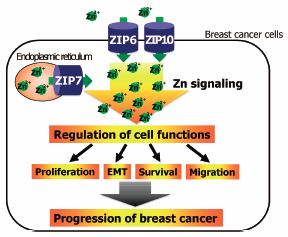 Graphical Abstract Fullsize ImageView full abstractDownload PDF (1887K) Full view HTML
Graphical Abstract Fullsize ImageView full abstractDownload PDF (1887K) Full view HTML
-
Tomohiro Nishimura, Kei Higuchi, Yuko Yoshida, Yuki Sugita-Fujisawa, K ...2018Volume 41Issue 10 Pages 1523-1529
Published: October 01, 2018
Released on J-STAGE: October 01, 2018
JOURNAL FREE ACCESS FULL-TEXT HTMLHypotaurine is a precursor of taurine and a physiological antioxidant that circulates in adult and fetal plasma. The purpose of the present study was to clarify whether hypotaurine is a substrate of Slc6a/gamma-aminobutyric acid (GABA) transporter family members. Radiolabeled hypotaurine was synthesized from radiolabeled cysteamine and 2-aminoethanethiol dioxygenase. The uptakes of [3H]GABA, [3H]taurine, and [14C]hypotaurine by HEK293 cells expressing mouse GAT1/Slc6a1, TAUT/Slc6a6, GAT3/Slc6a11, BGT1/Slc6a12, and GAT2/Slc6a13 were measured. TAUT and GAT2 showed strong [14C]hypotaurine uptake activity, while BGT1 showed moderate activity, and GAT1 and GAT3 showed slight but significant activity. Mouse TAUT and GAT2 both showed Michaelis constants of 11 µM for hypotaurine uptake. GAT2-expressing cells pretreated with hypotaurine showed resistance to H2O2-induced oxidative stress. These results suggest that under physiological conditions, TAUT and GAT2 would be major contributors to hypotaurine transfer across the plasma membrane, and that uptake of hypotaurine via GAT2 contributes to the cellular resistance to oxidative stress.
 Graphical Abstract Fullsize ImageView full abstractDownload PDF (810K) Full view HTML
Graphical Abstract Fullsize ImageView full abstractDownload PDF (810K) Full view HTML
-
Nan Si, Hajime Kanazawa, Katsuki Okuyama, Keisuke Imada, Hongjie Wang, ...2018Volume 41Issue 10 Pages 1530-1536
Published: October 01, 2018
Released on J-STAGE: October 01, 2018
JOURNAL FREE ACCESS FULL-TEXT HTML
Supplementary materialGranulation tissue formation during skin wound healing requires the migration and proliferation of dermal fibroblasts in the wound site, where a subsequent remodeling of extracellular matrices (ECM) occurs. An abnormality of ECM remodeling within the healing wound leads to fibrosis and a contracted scar. To evaluate whether acteoside, a phenylethanoid glycoside isolated from the leaves of Rehmannia glutinosa LIBOSCH., exhibits wound-healing actions, we examined the effect of acteoside on the expression of matrix metalloproteinases (MMPs) in normal human dermal fibroblasts (NHDF). Acteoside dose- and time-dependently augmented the activation of the precursor of MMP-2 (proMMP-2/progelatinase A) in untreated- and interleukin-1β-treated NHDF, while the alteration of the MMP-2 gene expression was negligible. The acteoside-induced proMMP-2 activation was associated with the augmented membrane-type 1 MMP (MT1-MMP) expression in the NHDF. In addition, the proMMP-2 activation was enhanced by two aglycones in acteoside: caffeic acid and 3,4-dihydroxyphenylethanol, which consist of catechol. However, there was no change in the proMMP-2 activation in other catechol derivatives: homovanillyl alcohol- and homovanillic acid-treated NHDF, indicating that catechols in acteoside were requisite for the regulation of the MMP activation and expression in NHDF. Furthermore, the proMMP-2 activation by acteoside was selectively inhibited by LY294002, a potent phosphatidylinositol-3-kinase (PI3K) inhibitor. These results provide novel evidence that acteoside augments proMMP-2 activation along with an increase in MT1-MMP expression through a PI3K signal pathway in NHDF. Thus, acteoside is likely to be an attractive candidate that facilitates ECM remodeling in the skin wound repair process.
 Graphical Abstract Fullsize ImageView full abstractDownload PDF (1290K) Full view HTML
Graphical Abstract Fullsize ImageView full abstractDownload PDF (1290K) Full view HTML -
Yukinobu Kodama, Ryo Noda, Kayoko Sato, Hitomi Harasawa, Tomoaki Kuros ...2018Volume 41Issue 10 Pages 1537-1542
Published: October 01, 2018
Released on J-STAGE: October 01, 2018
JOURNAL FREE ACCESS FULL-TEXT HTMLFolate receptors are overexpressed on the surface cancer cells. We successfully constructed a new gene delivery vector of methotrexate (MTX)-coated plasmid DNA–polyethylenimine (pDNA–PEI) complexes (PEI complexes) by electrostatic binding. The stable anionic nanoparticle was optimized at MTX charge ratios of 120 or more. pDNA–PEI–MTX complexes (MTX complexes) demonstrated gene expression efficiency as high as cationic pDNA–PEI complexes in the mouse melanoma cell line, B16-F10. The MTX complexes were taken up by the cell-specific uptake mechanisms via the folate receptor. MTX-coated complexes are useful as endocytosis ligands. The MTX120 complexes exhibited no blood aggregation. The transgene efficiency of MTX120 complexes in the liver and spleen after their intravenous administration was higher than that of PEI complexes. Therefore, MTX complexes are expected as a new gene vector in the future.
 Graphical Abstract Fullsize ImageView full abstractDownload PDF (2261K) Full view HTML
Graphical Abstract Fullsize ImageView full abstractDownload PDF (2261K) Full view HTML -
Jiansheng Li, Ya Li, Xiaofan Lu, Haifeng Wang, Yang Wang, Hangjie Li, ...2018Volume 41Issue 10 Pages 1543-1553
Published: October 01, 2018
Released on J-STAGE: October 01, 2018
Advance online publication: July 28, 2018JOURNAL FREE ACCESS FULL-TEXT HTMLThe risk-window (RW) of chronic obstructive pulmonary disease (COPD) is a period after an acute exacerbation (AE) but before the following stable phase, in which exacerbations are easy to relapse. We established a sequential COPD-AE-RW rat model by cigarette-smoke and bacterial exposures in the first 8 weeks, and was challenged with Klebsiella pneumonia to mimic an AE on Day 1 of week 9, and found that body temperature, white blood cell, neutrophils, serum amyloid A (SAA) and C-reactive protein (CRP) increased in AECOPD rats 24 h after challenge, and declined in 3–6 d, while lung function declined in 48 h, and recovered in 7–16 d. When sacrificed, pulmonary forced expiratory volume (FEV)100 and FEV300 decreased, while elevated bronchoalveolar lavage fluid (BALF) neutrophils and marked airway inflammation, remodeling and emphysema were observed. Sequential COPD-AE-RW rat model was established successfully and AE phase lasts for approximately 5–7 d, followed by a 10-d around risk-window.
 Graphical Abstract Fullsize ImageView full abstractDownload PDF (6960K) Full view HTML
Graphical Abstract Fullsize ImageView full abstractDownload PDF (6960K) Full view HTML -
Moeko Doi, Yuki Sagawa, Takumi Tanaka, Taeko Mizutani, Yuri Okano, Hit ...2018Volume 41Issue 10 Pages 1554-1560
Published: October 01, 2018
Released on J-STAGE: October 01, 2018
JOURNAL FREE ACCESS FULL-TEXT HTMLSacran, a polysaccharide isolated from the alga Aphanothece sacrum (Suizenji-nori), has unique physical and physiological characteristics. In a previous study, we reported that sacran improves skin conditions in individuals who suffer from atopic dermatitis (AD), focusing on its trapping function against extrinsic stimuli compared with hyaluronic acid (HA). First, we examined the penetration of sacran through stratum corneum (SC) with an impaired barrier function using immature reconstructed human epidermal equivalents. Sacran penetrates the SC to living cell layers of the epidermis, which suggested that sacran would attenuate adverse influences in keratinocytes caused by extracellular factors such as irritants or proinflammatory cytokines such as interleukin 1α (IL-1α). Sacran markedly reduced the cell damage induced by a nonionic detergent, sodium lauryl sulfate (SLS). Moreover, sacran restored the elevation of intracellular reactive oxygen species (ROS) levels stimulated by SLS and by IL-1α. These effects of sacran were superior to those of HA. In order to investigate the restoration effects of sacran, the influence of sacran on the physical properties of lipid bilayers was evaluated by measuring the order parameter using the ESR spin-labeling method. Because sacran failed to cause changes in the order parameters of liposomes and HaCaT keratinocytes, these results indicate that sacran does not interact with lipid bilayers although it restored changes in the order parameter caused by SLS. The sum of these results demonstrates that sacran reduces the influence of extracellular stimuli by its trapping effects. We conclude that the improving action of sacran is based on its trapping effect.
 Graphical Abstract Fullsize ImageView full abstractDownload PDF (2233K) Full view HTML
Graphical Abstract Fullsize ImageView full abstractDownload PDF (2233K) Full view HTML -
Takashi Ito, Yuuki Hanahata, Keita Kine, Shigeru Murakami, Stephen W. ...2018Volume 41Issue 10 Pages 1561-1566
Published: October 01, 2018
Released on J-STAGE: October 01, 2018
JOURNAL FREE ACCESS FULL-TEXT HTMLDietary taurine deficiency results in dilated cardiomyopathy in cats while in mice taurine deficiency produced by knocking out the taurine transporter (TauT) gene leads to a reduction in cardiac function with advancing age. The present study elucidated the involvement of cardiac fibrosis in the aging-dependent cardiac disorder of the TauT-knockout (TauTKO) mouse. Old (18–24-month-old) TauTKO mice, but not young (3–5-month-old) mice, exhibit cardiac fibrosis. Transcriptome microarray analysis revealed an increase in pro-fibrotic genes, such as S100A4, ACTA2 and CTGF, in both young and old TauTKO hearts. Based on transcriptome-pathway analysis the genes involved in “organization of extracellular matrix,” such as LGALS3, are enriched in old TauTKO hearts compared to old wild-type hearts, suggesting the contribution of these genes to fibrosis. In conclusion, taurine depletion predisposes the heart to fibrosis, which leads to cardiac fibrosis upon aging.
 Graphical Abstract Fullsize ImageView full abstractDownload PDF (3005K) Full view HTML
Graphical Abstract Fullsize ImageView full abstractDownload PDF (3005K) Full view HTML -
 Hiroaki Tanaka, Toshihiro Miura, Takenori Yamashita, Misao Yoneda, Sat ...2018Volume 41Issue 10 Pages 1567-1573
Hiroaki Tanaka, Toshihiro Miura, Takenori Yamashita, Misao Yoneda, Sat ...2018Volume 41Issue 10 Pages 1567-1573
Published: October 01, 2018
Released on J-STAGE: October 01, 2018
Advance online publication: July 13, 2018JOURNAL FREE ACCESS FULL-TEXT HTMLWe evaluated the suitability of Nagoya Shibata Yasuda (NSY) mice as an animal model for examining the influence of a glucose metabolism disorder on bone integrity, using Institute of Cancer Research (ICR) mice as controls. We selected six NSY and ICR mice each that were matched for weight, and measured serum glucose levels, serum insulin levels, and conducted an oral glucose tolerance test. Histological sections of the femurs of both mouse lines were prepared, and the bone strength, mass, and microstructure of the femur were compared, along with bone metabolism. Serum glucose levels were significantly higher in the NSY mice than in the control mice, but body weight and serum insulin levels did not differ between the groups. Bone mass, microstructure, and strength of the femur, and bone metabolism were lower in the NSY mice than in the control mice. In the cortical bone of the femur in the NSY mice, several parts were not stained with eosin, demonstrating a strong negative correlation between serum glucose levels and bone mineral density; however, there was a negative correlation between serum glucose levels and bone metabolic markers. The bone turnover rate in the NSY mice was decreased by hyperglycemia, resulting in a thinner and shorter femur, reduced cortical and trabecular areas, and lower bone mass compared to those of the control mice. Collectively, these results suggest deteriorated bone strength of the femur in NSY mice, serving as a useful model for studying the link between glucose metabolism and bone integrity.
 Graphical Abstract Fullsize ImageView full abstractEditor's pick
Graphical Abstract Fullsize ImageView full abstractEditor's pickType 2 diabetes mellitus (T2DM) animal models are often used in basic research on diabetic osteoporosis. The article by Tanaka et al. elucidated hyperglycemia contributed to a decrease in bone metabolism turnover in the T2DM animal model NSY mice, resulting in a thinner and shorter femur, lower cortical and trabecular area, and lower bone mass. Their results suggest that these effects contribute to the deteriorated bone strength of the femur in NSY mice, and the NSY mouse could serve as an appropriate T2DM animal model for examining the specific effect of hyperglycemia on bone integrity, using the ICR mouse as a control.
Download PDF (800K) Full view HTML -
Ilona Mandrika, Andra Tilgase, Ramona Petrovska, Janis Klovins2018Volume 41Issue 10 Pages 1574-1580
Published: October 01, 2018
Released on J-STAGE: October 01, 2018
JOURNAL FREE ACCESS FULL-TEXT HTMLMembers of the hydroxycarboxylic acid receptor (HCA1–3) family are mainly expressed in adipocytes and immune cells. HCA2 ligand, niacin, has been used for decades as lipid-modifying drug. Recent studies suggest that HCA ligands can be involved in the modulation of inflammatory processes. In this study, we evaluated the effects of HCA1–3 ligands on adipose differentiation and cytokine expression in human adipocytes and macrophages. Simpson–Golabi–Behmel syndrome (SGBS) preadipocytes were induced to differentiate into adipocytes for 8 d in the presence or absence of HCA ligands and evaluated for lipid accumulation and adipogenic gene expression. The inhibitory effects of the ligands on the expression and production of cytokines were measured in lipopolysaccharide (LPS)-stimulated adipocytes and THP-1 macrophage cells. Preadipocytes treated with HCA ligands showed no changes in the capacity to differentiate into adipocytes and no significant alteration in peroxisome proliferator activated receptor γ (PPARγ) or its target gene expression. HCA2–3 ligands significantly downregulated LPS-induced expression of interleukin (IL)-6 (53–64%), tumor necrosis factor-α (TNF-α) (55–69%) and IL-8 (51–59%) in adipocytes and macrophages. IL-1β inhibition (58–68%) by HCA2–3 ligands was observed only in adipocytes. Furthermore, LPS increased the expression of HCA2–3 in adipocytes and macrophages and this expression was decreased by treatment with their ligands. These results suggest that HCA ligands modulated LPS-mediated pro-inflammatory gene expression in both macrophages and adipocytes without affecting adipogenesis. Therefore, targeting HCA2 and HCA3 would be beneficial in treating inflammation conditions associated with atherosclerosis and obesity.
 Graphical Abstract Fullsize ImageView full abstractDownload PDF (2007K) Full view HTML
Graphical Abstract Fullsize ImageView full abstractDownload PDF (2007K) Full view HTML -
Yunbo Zhang, Wanying Zhang, Zhanju Wang, Xiaolin Na, Cheng Wang2018Volume 41Issue 10 Pages 1581-1585
Published: October 01, 2018
Released on J-STAGE: October 01, 2018
JOURNAL FREE ACCESS FULL-TEXT HTML
Supplementary materialThe objective of this study was to confirm the effect of maternal genistein exposure on body weight of male offspring and the metabolic alterations associated with maternal genistein-induced obesity. Pregnant female Sprague–Dawley (SD) rats were supplemented with 300 mg/kg diet of genistein (GEN) or no genistein (CON) throughout pregnancy and lactation. The growth of male offspring was investigated until 12 week age and the mechanism of obesity was studied using metabonomics by ultra performance liquid chromatography and quadrupole time-of-flight (UPLC Q-TOF) MS with electrospray ionization in positive ESI mode (ESI+). Compared with the CON group, body weight, fat pad and food intake of male offspring in GEN group were increased significantly at the age of weeks 10 to 12 (p<0.05). Ten urine principal metabolites contributing to the clusters were identified, including increased 8-Isoprostaglandin F2a, and decreased L-Proline, Betaine, L-Acetylcarnitine, Norsalsolinol, Indoleacrylic acid, L-Tryptophan, Lysophosphatidylcholines (LysoPC) (20 : 4), Lysophosphatidylethanolamines (LysoPE) (18 : 1) and LysoPC (O-18 : 0). Our results confirmed weight-increasing effects of maternal genistein exposure, accompanied by favorable changes in metabolites in the male offspring’ urine. Therefore, this research enables us to better understand obesity and predict risk of obesity-related disease by studying metabolites present in the urine.
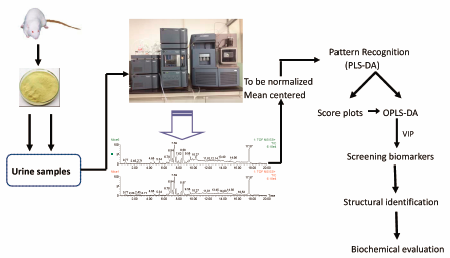 Graphical Abstract Fullsize ImageView full abstractDownload PDF (671K) Full view HTML
Graphical Abstract Fullsize ImageView full abstractDownload PDF (671K) Full view HTML -
Yoshihiro Higashi, Kentaro Higashi, Asami Mori, Kenji Sakamoto, Kunio ...2018Volume 41Issue 10 Pages 1586-1592
Published: October 01, 2018
Released on J-STAGE: October 01, 2018
JOURNAL FREE ACCESS FULL-TEXT HTML
Supplementary materialResveratrol, which is a polyphenol found in grapes, peanuts, and other plants, has health benefits for various chronic diseases. The aim of the present study was to examine the effect of resveratrol on cataract formation in diabetic rats. Male Wistar rats (7-week-old) were treated with streptozotocin, and the streptozotocin-treated animals were administered 5% D-glucose in drinking water to promote the formation of cataracts by inducing severe hyperglycemia. Resveratrol supplementation (10 or 30 mg/kg/d) in drinking water was initiated immediately after induction of diabetes was confirmed. The full lens images of the horizontal plane were captured with the digital camera system which we developed. Cataract formation was assessed by an observer-based scoring method and by quantitative analysis of digital images of the lens. Cataracts at the peripheral region of the lens were detected 2 weeks after induction of hyperglycemia and progressed depending on the length of the diabetic period. The majority of them developed severe cataracts after 9 weeks of hyperglycemia. Resveratrol did not prevent the appearance of diabetic cataracts but significantly delayed the progression of cataracts compared with controls. The contents of sorbitol and protein carbonyls in lenses of diabetic rats were higher than those of control rats. Resveratrol suppressed the increase in protein carbonyls, but not of sorbitol, in diabetic lenses. These results suggest that resveratrol delays the progression of diabetic cataracts partially through attenuation of oxidative damage to lens proteins. Resveratrol may be beneficial in preventing the progression of diabetic cataracts.
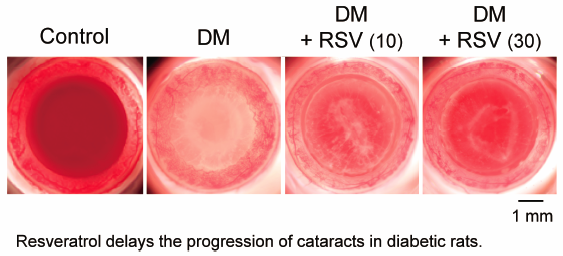 View full abstractDownload PDF (1650K) Full view HTML
View full abstractDownload PDF (1650K) Full view HTML -
Kagaku Azuma, Tatsuya Toyama, Masahisa Katano, Kyoko Kajimoto, Sakurak ...2018Volume 41Issue 10 Pages 1593-1599
Published: October 01, 2018
Released on J-STAGE: October 01, 2018
JOURNAL FREE ACCESS FULL-TEXT HTML
Supplementary materialYokukansan (YKS) is a traditional Japanese herbal medicine. It has been currently applied for treating behavioral and psychological symptoms of dementia in Japan. We investigated the effect of YKS on learning ability, hippocampal cell proliferation, and neural ultrastructural features in senescence-accelerated mouse prone 8 (SAMP8), a proposed animal model of Alzheimer’s disease. Five-month-old male SAMP8 mice were randomly assigned to control and experimental groups. The control group had drug-free water ad libitum. The experimental mice were given 0.15% aqueous solution of YKS orally for eight weeks. Learning ability was assessed in Morris water maze test. Hippocampal cell proliferation was investigated using bromodeoxyuridine immunohistochemical method. The neural ultrastructural features, including myelin sheath and synapse, were investigated electron microscopy. Administration with YKS improved the hippocampal cell proliferation in dentate gyrus, and ameliorated learning impairment in SAMP8 mice. Numerous lipofuscin inclusions were presented in hippocampal neurons of the control mice. However, little were found after treatment with YKS. Myelin sheath was thicker and postsynaptic density length was longer after treatment with YKS. Administration with YKS ameliorated learning impairment in SAMP8 mice, mediated at least partially via delaying neuronal aging process, neurogenesis, myelin sheath and synaptic plasticity in the hippocampus. These results suggest that YKS might be effective for preventing hippocampus-dependent cognitive deficits with age.
 Graphical Abstract Fullsize ImageView full abstractDownload PDF (3347K) Full view HTML
Graphical Abstract Fullsize ImageView full abstractDownload PDF (3347K) Full view HTML -
Yusuke Kawai, Chiaki Kawabata, Miako Sakaguchi, Takahiko Tamura2018Volume 41Issue 10 Pages 1600-1605
Published: October 01, 2018
Released on J-STAGE: October 01, 2018
JOURNAL FREE ACCESS FULL-TEXT HTMLBaculovirus vectors (BVs) enable safe and efficient gene delivery to mammalian cells and are useful in a wide range of applications, including gene therapy and in vivo analysis of gene functions. We previously developed BVs expressing malaria sporozoite surface proteins for targeting liver cells or hepatocytes. However, BVs are known to be very vulnerable to complement attack and efforts to overcome their inactivation based on complement are important. In this study, BVs expressing complement regulatory proteins (CRPs) on the surfaces of virions were developed to inhibit complement reactions. Decay accelerating factor (DAF; CD55)-type BVs exhibited significantly higher complement resistance than control BVs without any CRPs in HepG2 cells transduction, although the transduction efficacy of DAF-type BV was low. In contrast, CD46-DAF-CD59 fusion type BVs showed significantly higher transduction efficacy and complement resistance than both control and DAF-type BVs. DAF-type and CD46-DAF-CD59 type BVs repressed formation of the membrane attack complex, a terminal product of complement reaction cascades, induced by BVs. These results suggest that the CD46-DAF-CD59 fusion construct confers complement protection ability superior to that of the DAF construct in gene delivery under complement active serum.
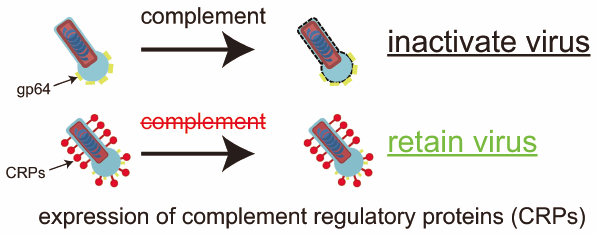 Graphical Abstract Fullsize ImageView full abstractDownload PDF (1045K) Full view HTML
Graphical Abstract Fullsize ImageView full abstractDownload PDF (1045K) Full view HTML
-
HyeongSeob Kwak, Hongyan An, Md Badrul Alam, Won-Sik Choi, Sang Yong L ...2018Volume 41Issue 10 Pages 1606-1610
Published: October 01, 2018
Released on J-STAGE: October 01, 2018
JOURNAL FREE ACCESS FULL-TEXT HTMLβ-Escin, a natural triterpene saponin was extracted from Aesculus hippocastanum seeds, which have been widely used to treat inflammation in traditional medicine. In an effort to study the possible anti-tumor effects of β-escin, we performed wound healing, invasion, and adhesion assays to examine the effects of β-escin on cell migration, invasion, and angiogenesis. Our results revealed that β-escin inhibits cell migration as well as motility in B16F10 and SK-MEL5 cells in a dose-dependent manner. RT-PCR and Western blot analysis showed that β-escin increased TIMP-1, -2 while significantly downregulated phosphorylated extracellular signal-regulated kinase (p-ERK) expression, and suppressing nuclear factor-kappa B (NF-κB) and inhibitor of nuclear factor-kappa B (IκB) expression. Overall, the data from the current study suggest that β-escin has the potential for inhibiting both metastatic and angiogenic activities, and are the earliest evidence for the involvement of the NF-κB/IκB signaling in β-escin-induced anti-tumor effects.
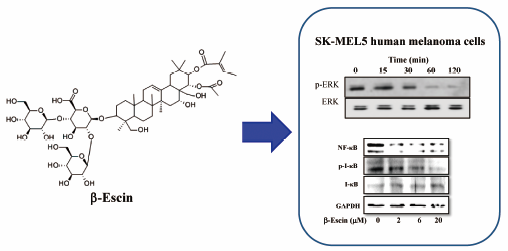 Graphical Abstract Fullsize ImageView full abstractDownload PDF (1272K) Full view HTML
Graphical Abstract Fullsize ImageView full abstractDownload PDF (1272K) Full view HTML -
Hippocampal Cholinergic Neurostimulating Peptide Suppresses Acetylcholine Synthesis in T LymphocytesYuka Saito, Masato Mashimo, Akari Nobeyama, Kana Murakami, Takeshi Fuj ...2018Volume 41Issue 10 Pages 1611-1614
Published: October 01, 2018
Released on J-STAGE: October 01, 2018
JOURNAL FREE ACCESS FULL-TEXT HTMLLymphocytic cholinergic system has important roles in T cell functions, including immune responses and proliferation and differentiation of immune cells. T lymphocytes exclusively produces acetylcholine (ACh) via choline acetyltransferase (ChAT), activating their muscarinic and nicotinic ACh receptors (mAChRs and nAChRs, respectively) in an autocrine and paracrine manners. Hippocampal cholinergic neurostimulating peptide (HCNP) is an undecapeptide cleaved from N-terminal of phosphatidylethanolamine-binding protein 1 (PEBP1). HCNP enhances ACh synthesis through upreglation of ChAT expression in septo-hippocampal cholinergic neurons and participates in neuronal development and differentiation. Although PEBP1 and HCNP appears to be distributed ubiquitously in tissues and cells including spleen, its functions in immune cells have not been understood. In the present study, we observed that PEBP1 is also expressed in human and murine T cells. Long-term exposure to HCNP suppressed ChAT expression in MOLT3 human leukemic T cells, resulting in decreased release of ACh. HCNP also decreased the expression of extracellular signal-regulated kinase (ERK). Thus, HCNP appears to suppress lymphocytic cholinergic signaling, which might act as an immune modulator.
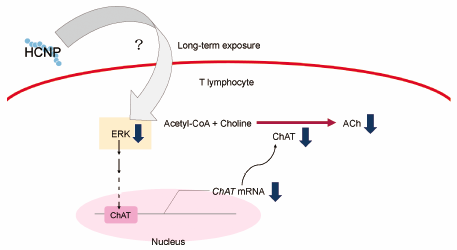 Graphical Abstract Fullsize ImageView full abstractDownload PDF (1397K) Full view HTML
Graphical Abstract Fullsize ImageView full abstractDownload PDF (1397K) Full view HTML -
Akikazu Asada, Hideki Hayakawa, Natsuki Yanase, Kanae Abe, Fuminori Sa ...2018Volume 41Issue 10 Pages 1615-1619
Published: October 01, 2018
Released on J-STAGE: October 01, 2018
JOURNAL FREE ACCESS FULL-TEXT HTMLIn recent times, oncolytic viruses expressing an extraneous gene have attracted great interest; in fact, they have been engaged in multiple applications, such as medicine for cancer. Our group made an oncolytic adenovirus, namely, OBP-301, for use in treating solid cancers and press clinical trial to get approval for a pharmaceutical product. In this study, we applied a flow cytometry-based method to determine the titer of adenoviruses expressing an extraneous gene as well as assess their quality. We considered using the green fluorescent protein (GFP)50 titer as a measure of viral quality. The GFP50 titer (GFP50/mL) is the viral load required to render the HeLa S3 cell line 50% GFP-positive by analysing flow cytometry data. We measured the GFP50 titers for three types of recombinant adenoviruses (OBP-401, OBP-1101, and OBP-1106). We compared GFP50/mL and tissue culture infectious dose (TCID50/mL), a conventional titration index, and found that these titers showed a linear correlation, with a correlation coefficient of >0.9. Moreover, GFP50/mL showed high repetitive accuracy. We expect this flow cytometry-based method to be useful in case of clinically relevant viruses expressing an extraneous gene, in particular, to control viral quality.
 Graphical Abstract Fullsize ImageView full abstractDownload PDF (591K) Full view HTML
Graphical Abstract Fullsize ImageView full abstractDownload PDF (591K) Full view HTML -
Airi Ohsaki, Sei-ichi Tanuma, Mitsutoshi Tsukimoto2018Volume 41Issue 10 Pages 1620-1626
Published: October 01, 2018
Released on J-STAGE: October 01, 2018
Advance online publication: July 19, 2018JOURNAL FREE ACCESS FULL-TEXT HTMLExternal stimuli, such as radiation, induce inflammatory cytokine and chemokine production in skin, but the mechanisms involved are not completely understood. We previously showed that the P2Y11 nucleotide receptor, p38 mitogen-activated protein kinase (MAPK) and nuclear factor-kappa B (NF-κB) all participate in interleukin (IL)-6 production induced by γ-irradiation. Here, we focused on the transient receptor potential vanilloid 4 (TRPV4) channel, which is expressed in skin keratinocytes and has been reported to play a role in inflammation. We found that irradiation of human epidermal keratinocytes HaCaT cells with 5 Gy of γ-rays (137Cs: 0.75 Gy/min) induced IL-6 and IL-8 production. HaCaT cells treated with TRPV4 channel agonist GSK1016790A also showed increased IL-6 and IL-8 production. In both cases, IL-6/IL-8 production was not increased at 24 h after stimulation, but was increased at 48 h. ATP was released from cells exposed to γ-irradiation or TRPV4 channel agonist, and the release was suppressed by TRPV4 channel inhibitors. The γ-irradiation-induced increase in IL-6 and IL-8 production was suppressed by apyrase (ecto-nucleotidase), NF157 (selective P2Y11 receptor antagonist) and SB203580 (p38 MAPK inhibitor). GSK1016790A-induced inhibitor of kappa B-alpha (IκBα) decomposition, which causes NF-κB activation was suppressed by NF157 and SB203580, and γ-irradiation-induced IκBα decomposition was suppressed by TRPV4 channel inhibitors. Our results suggest that γ-irradiation of keratinocytes induces ATP release via activation of the TRPV4 channel, and then ATP activates P2Y11 receptor and p38 MAPK-NF-κB signaling, resulting in IL-6/IL-8 production.
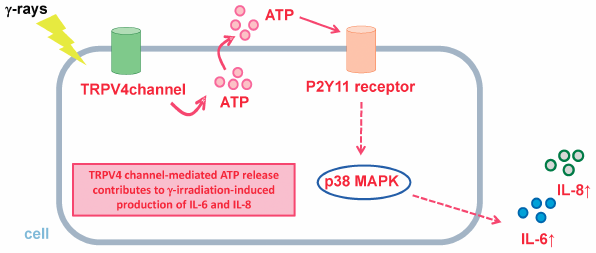 Graphical Abstract Fullsize ImageView full abstractDownload PDF (859K) Full view HTML
Graphical Abstract Fullsize ImageView full abstractDownload PDF (859K) Full view HTML
- |<
- <
- 1
- >
- >|